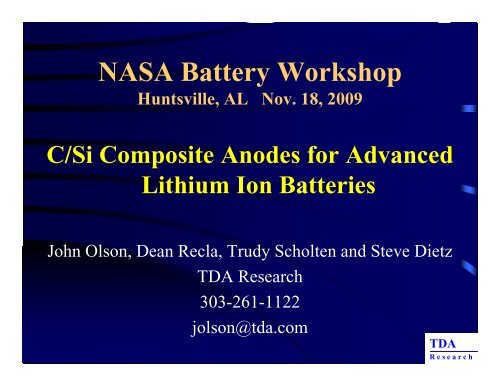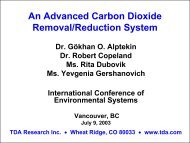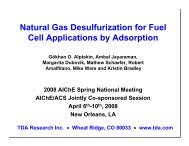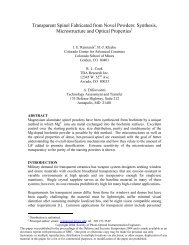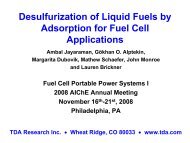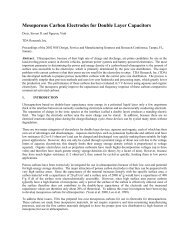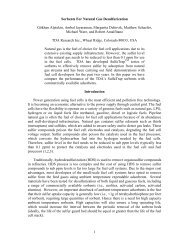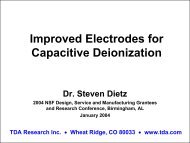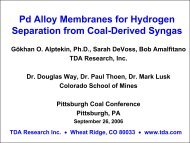C/Si Composite Anodes for Advanced Lithium Ion Batteries
C/Si Composite Anodes for Advanced Lithium Ion Batteries
C/Si Composite Anodes for Advanced Lithium Ion Batteries
Create successful ePaper yourself
Turn your PDF publications into a flip-book with our unique Google optimized e-Paper software.
NASA Battery WorkshopHuntsville, AL Nov. 18, 2009C/<strong>Si</strong> <strong>Composite</strong> <strong>Anodes</strong> <strong>for</strong> <strong>Advanced</strong><strong>Lithium</strong> <strong>Ion</strong> <strong>Batteries</strong>John Olson, Dean Recla, Trudy Scholten and Steve DietzTDA Research303-261-1122jolson@tda.comTDAR e s e a r c h
OUTLINE• Introduction to TDA Research• Technical Approach• Results– Capacity–Power– Irreversible capacity– Capacity fade• Future WorkTDAR e s e a r c h
TDA Research, Inc.www.tda.comWheat Ridge Facility22,500 ft 2 offices and labsSynthetic ChemistryCatalyst/Sorbent Synthesis/TestingCeramics ProcessingMachine and Electronics ShopsSEM (w/EDX), TOF Mass SpecGolden Facility27,000 ft 2 offices and labs27 fume hoodsSynthetic ChemistryCatalytic Process DevelopmentPilot Scale ProductionTDAR e s e a r c h
Goal Oriented ResearchPrivate, founded in 1987~ $12.5 million/year revenue in 2008Staff of 81, primarily il chemists andengineers, 2/3 of whom haveadvanced degrees (24 w/ Ph.D.)Commercial Products• SulfaTreat DO• Fullerenes• Conducting Polymers• Self-Heating Products• Sulfur Sorbents• Carbon Electrodes <strong>for</strong> DesalinationTDAR e s e a r c h
History of Commercial SuccessTDA’s business plan is to develop new technologies andlicense them to leading industrial companies•142 SBIR Phase IIs• Of 107 completed, 87have had Phase III fundingor sales• ~ $91.5 million in PhaseIII funding• Over $11.3 million indirect sales; ~$28.2 millionof licensed customer salesProprietary – TDA ResearchTDAR e s e a r c h
Activated Carbons <strong>for</strong> Ultracapacitors• PI: Dr. Steven Dietz• Low-cost production from sugar precursors• Larger voltage window than current carbons;2.85 V vs 2.7 VCapture regenerative brakingenergy in hybrid and fuel cellvehiclesLoad level in cars and electronic,reducing wear on the battery,improving power system stabilityand reducing weight• Faster charge / discharge (lower internalresistance)• Tailored pores allow liquid access to all thecarbon’s surface area• Joint development agreement <strong>for</strong>ultracapacitors with MeadWestvaco• Under evaluation by Maxwell Technologiesand othersDevelopment funded by DOE, NSFProprietary – TDA ResearchTDAR e s e a r c h
Engineered Pore-<strong>Si</strong>zeOptimizes Per<strong>for</strong>manceProprietary – TDA ResearchTDAR e s e a r c h
Key Personnel Are Experienced• Dr. John Olson – PI, Electrochemist– Joined TDA Research in 2007– 15 years experience in battery industry; Optima<strong>Batteries</strong>, Boundless Corp.– <strong>Lithium</strong>-ion, VRLA, Ultracapacitors, batterymanagement, charge algorithms– 3 patents• Dr. Steve Dietz – Carbon Synthesis– Invented pore size engineering of activated carbons– Applied to ultracapacitors and capacitive de-ionization– TDA scientist from 1993– 4 patents, 1 patents pendingTDAR e s e a r c h
<strong>Si</strong>licon as an Anode• 4200 mAh/g capacity (theoretical)• Li <strong>for</strong>ms alloy, rather than intercalatingti• 4.4 Li atoms per <strong>Si</strong> atom• Large expansion 280%• Cycling leads to rapid capacity loss due tocracking and loss of conductive matrixTDAR e s e a r c h
Ef<strong>for</strong>ts to Engineer <strong>Si</strong>licon <strong>for</strong>Li-<strong>Ion</strong> Battery <strong>Anodes</strong>• Nanoscale particle size – effectively extendslife, but Oswald ripening and agglomerationlead to capacity fade and high surface arearesults in SEI <strong>for</strong>mation and largeirreversible capacity loss• Graphite carbon matrix or coatings– alsoeffective, but capacity fade still needsimprovement and SEI growth an issueTDAR e s e a r c h
<strong>Si</strong>/C <strong>Composite</strong>s+ xLi+-xLi +<strong>Si</strong>Li x <strong>Si</strong>Hard carbon matrix with encapsulated silicon• Prevent SEI layer <strong>for</strong>mation/re-<strong>for</strong>mation on <strong>Si</strong> particles• Provide highly conductive matrix• Prevent agglomeration of dispersed <strong>Si</strong> particlesProprietary – TDA ResearchTDAR e s e a r c h
Hard d( (non-graphitizable)Carbon vs Graphites• Higher specific capacity and better chargeacceptance• Lower energy density• Better cycle life, less volume change and morestable SEI layer• Higher irreversible capacity due to surface groupsand water adsorption• Higher surface area leading to increased SEI<strong>for</strong>mation• Hydrogen incorporation causes cycling hysterisisTDAR e s e a r c h
Synopsis of Work Ef<strong>for</strong>tThere were three major factors studied:(1) <strong>Composite</strong>s fired at differenttemperatures (> 1200 C or 1000 C)(2) <strong>Composite</strong>s made with nano <strong>Si</strong> versus44 um <strong>Si</strong> particle sizes(3) <strong>Composite</strong>s using different carbonsourcesTDAR e s e a r c h
Experimental Test Methods• Anode <strong>for</strong>mulation: 87.5% active, 5% Super P, 5%PVDF in NMP cast onto Cu foil (25 um)• Half 2025 cells: Li foil, Celgard separator, 1 M LiClO 4EC:DEC 1:1 (Dahn charge method)• Full 2025 cells: Commercial LiNi 0.8 Co 0.2 O 2 cathode,Celgard separator, 1 M LiClO 4 EC:DEC 1:1• Typical charge/discharge rates: C/2 – C/4• Resistance measurements using current pulse at 20 ms• Irreversible capacity expressed as Ah charge /Ah dischargeTDAR e s e a r c h
Started with Control CarbonsFired at 1200 – 1400 CCycle 1200 1300 1400 CommercialDensity (g/ml) 0.645 0.594 0.683 0.691BET (m 2 /g) 0.69 0.42 0.14Capacity 1st 375 512 Bad data 566(mAh/g) 2nd 379 471 5453rd 371 442 5784th 387 384Capacity 1st 244 304 325(mAh/ml) 2nd 238 280 3133rd 248 262 3324th 260 228Irrev. Capa1st 131 125(%) 2nd 103 105 1033rd 104 100 1044th 103 102TDAR e s e a r c h
C/<strong>Si</strong> <strong>Composite</strong>s Fired at 1300 CWere Inactive<strong>Si</strong>C<strong>Si</strong><strong>Si</strong><strong>Si</strong>C<strong>Si</strong>C<strong>Si</strong><strong>Si</strong><strong>Si</strong><strong>Si</strong>1300 C 1000 C<strong>Si</strong>C <strong>for</strong>med at 1300 C, but not at 1000 CTDAR e s e a r c h
Process Conditions Changed toReduce Surface Areas450400350a (m2/g)Surface Are3002502001501005000 2 4 6 8 10 12 14 16Sample (#)TDAR e s e a r c h
Initial C/<strong>Si</strong>-nano <strong>Composite</strong>shad Relatively Low CapacitiesSample mAh/g mAh/ml % <strong>Si</strong>SO26 618 147 20SO27 545 140 20So we evaluated some <strong>Si</strong> anodecontrolsTDAR e s e a r c h
Initial <strong>Si</strong>-nano Controls AlsoShowed Low CapacityCapacity400035003000Capacity (m mAh/g)2500200015001000<strong>Si</strong> nano<strong>Si</strong> 325 mesh50001 2 3 4 5Cycle (#)TDAR e s e a r c h
C/<strong>Si</strong> <strong>Composite</strong>s With 44 um <strong>Si</strong>Particles Showed Good CapacitySample mAh/g mAh/ml %<strong>Si</strong>SO32 1080 305 20SO36 1510 595 40SO38 1270 500 40But high capacity fade!TDAR e s e a r c h
Dispersion of Nano<strong>Si</strong> Resultedin Theoretical CapacityCapacity450040003500Capacity (mA Ah/g)30002500200015001000500<strong>Si</strong> nano<strong>Si</strong> 325 mesh<strong>Si</strong> disp nano01 2 3 4 5Cycle (#)TDAR e s e a r c h
Evaluated a Second Sugar Sourceto Obtain Better Dispersion44 um <strong>Si</strong>Sample mAh/g mAh/ml Carbon Source % <strong>Si</strong>32 1080 305 Type 1 2043 1060 436 Type 2 2044 993 426 Type 2 20Nano <strong>Si</strong>Sample mAh/g mAh/ml Carbon Source % <strong>Si</strong>26 618 147 Type 1 2027 545 140 Type 1 2040 656 273 Type 2 20Only capacities were about the sameTDAR e s e a r c h
Carbon Stabilized <strong>Si</strong> CapacityCapacity Fade120100pacity (%)Normalised Ca80604020323638434445<strong>Si</strong> 325 mesh01 2 3 4 5Cycle (#)TDAR e s e a r c h
Carbon Also Stabilized <strong>Si</strong>-nanoCapacity Fade120110Normalized Capacity (%)100908070262740Disp. <strong>Si</strong> nano<strong>Si</strong> nano601 2 3 4 5Cycle (#)TDAR e s e a r c h
Type 2 Carbon Has BetterCapacity Fade Than Type 1110105Normalized Capacity (%)10095908580533344275701 2 3 4 5Cycle (#)TDAR e s e a r c h
Irreversible Capacities areVariable, but Encouraging240C/<strong>Si</strong> nano220200Irreversible Capacity(%)18016044 um C/<strong>Si</strong> Carbons14012010032 36 38 43 44 45 Type 1 Type 2 Com 26 27 40SampleTDAR e s e a r c h
Power is Dependent onLoading Level of <strong>Si</strong>Rf vs DOD7060Rf (o ohm)5040302020%40%40%20% (2)20% (2)0%10044 um <strong>Si</strong>0 20 40 60 80 100 120DOD (%)C/44 um <strong>Si</strong>TDAR e s e a r c h
Type 2 Carbon Also SlightlyBetter <strong>for</strong> Power7060Resistan nce (ohm)5040302020% Type 120% Type 120% Type 20% Type 10% Type 21000 20 40 60 80 100 120DOD (%)C/<strong>Si</strong> nanoTDAR e s e a r c h
Cycle Life Will Be Focus ofFuture Ef<strong>for</strong>t120010008006000%0%20%20%40%40%TDAR e s e a r c hCapacity (Ah/g)400200017414722029336643951258565873180487795010231096116912421315138814611534Cycle (#)
Resistance Increase NotExcessive0% <strong>Si</strong> 20% <strong>Si</strong>3545304025352030Rdis (ohm m)151050-5-100 20 40 60 80 100 120Rdis (oh m)25201510500 20 40 60 80 100 120DOD (%)DOD (%)TDAR e s e a r c h
Economic Analysis FavorsLarger Particle <strong>Si</strong>ze <strong>Si</strong>44 um <strong>Si</strong> Nano <strong>Si</strong>($/kg) ($/kg)Materials Cost 82 8.2 202.4Production Cost 17.7 211.9TDAR e s e a r c h
Future Ef<strong>for</strong>t• Optimize firing temperature and conditions• Obtain better dispersion of <strong>Si</strong> particles in sugarprecursors• Evaluate <strong>Si</strong> particles size between 44 um andNano (per<strong>for</strong>mance vs. economics)• Evaluate carbon coatings to deactivate surfaceactivity and extend life• Scale up production to pilot plant (kg) levels• Produce commercial prototype cells <strong>for</strong> deliveryand testTDAR e s e a r c h
Thanks to NASA JSC <strong>for</strong> FundingNASA Phase I SBIRContract #: NNX09CE58PCOTR: Judy JeevarajanThank You <strong>for</strong> Your InterestTDAR e s e a r c h


